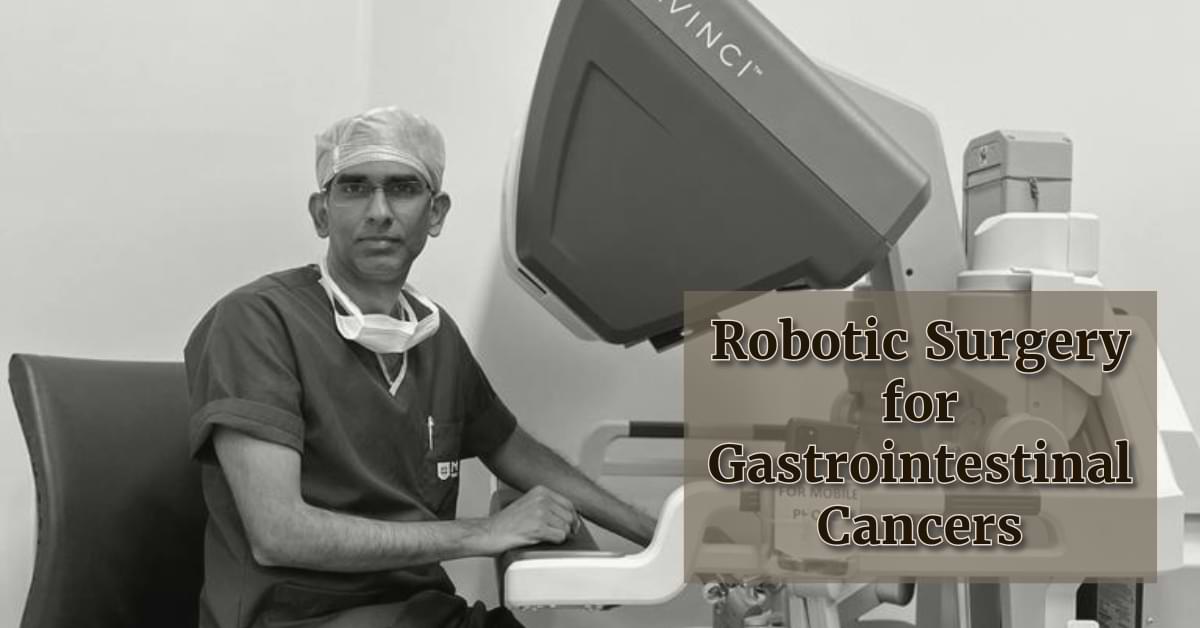Robotic Surgery for Gastrointestinal Cancers
Dr. Nikhil Agrawal | Last reviewed

Technological advancements have played a major role in the surgical treatment of cancer by enhancing precision, minimising invasiveness, and improving patient outcomes. For Gastrointestinal (GI) cancers, minimally invasive (keyhole) surgery offers significant advantages over traditional open surgery. Smaller incisions mean less pain, lower risk of infection, shorter hospital stays, and faster recovery.
One important technical innovation is Robotic Surgery. Robotic system’s enhanced vision and precision make complex minimally invasive cancer surgeries easier. It enhances the capabilities of the surgeon's hands.
Understanding Robotic Surgery
Robotic surgery combines the skill and expertise of a surgeon with the vision, precision, and flexibility of robotic technology. The robotic system features a 3D high-definition camera system for clear and enhanced vision with depth perception. It comprises a surgical console, where the surgeon sits, and robotic arms equipped with surgical instruments. The surgeon controls the instruments through the console, providing unparalleled precision, dexterity, and range of motion. The tiny wristed instruments can bend and rotate in ways the human hand cannot, allowing the surgeon to operate in tight spaces.
During robotic surgery, the surgeon makes minor cuts in the abdomen and inserts special tubes called ports. The robotic arms are connected to these ports, and the instruments mounted on these robotic arms go through the ports to do the surgery. A slender camera is also inserted through one port to show the surgeon a clear view of the inside. The surgeon controls the robotic arms from a console nearby, and an assistant helps by changing the instruments and aiding as needed.
Robotic surgery for GI Cancers
Gastrointestinal (GI) cancers include Oesophageal cancer, Stomach cancer, Colon and rectum (large intestine) cancer, Gallbladder cancer, Bile duct cancer (cholangiocarcinoma), Pancreatic cancer, Liver cancer (hepatocellular carcinoma), Neuroendocrine tumours, Gastrointestinal stromal tumours, Abdominal sarcomas and Appendicular tumours. These cancers present significant challenges because of their complexity and intricate anatomical location. Robotic surgery is an advanced tool for the surgical management of GI cancers, offering advantages over traditional open surgery and conventional laparoscopic techniques.
Advantages of Robotic surgery
Enhanced Precision and Visualization
Robotic surgery provides the surgeon with high-definition 3D visualisation of the surgical field. The enhanced depth perception allows for better identification of critical structures and focused movements. The robotic arms' ability to manoeuvre in a 360-degree range of motion facilitates intricate dissections, especially in deep and narrow spaces.
Minimally Invasive Approach
Compared to open surgery, robotic surgery involves smaller incisions, resulting in reduced trauma. This translates into several benefits, including less blood loss, decreased postoperative pain, shorter hospital stays, and faster recovery times. Patients who undergo robotic surgery for GI cancers often experience a quicker return to their daily activities and improved overall quality of life.
Reduced Complication Rates
The precise movements of robotic arms, enhanced vision and range of motion, coupled with the surgeon's expertise, contribute to a lower risk of complications during surgery. The minimally invasive nature of surgery reduces the chances of wound infections, hernias, and other postoperative complications. Additionally, the improved visualisation of the surgical site enables the surgeon to avoid inadvertent damage to vital structures, further reducing the risk of complications.
Equivalent Long-term Oncological Outcomes
For GI cancers, achieving complete tumour resection with lymph nodes is paramount to long-term survival. Robotic surgery facilitates meticulous dissection and precise removal of cancerous tissue while preserving critical structures.
Robotic procedures
- Robotic Colon Cancer Surgery (Colectomy)
- Robotic Surgery for Rectal Cancer Including Sphincter Preserving
- Robotic Pancreatic Cancer Surgery (Whipple Procedure and Pancreatectomy)
- Robotic Esophageal Cancer Surgery (Esophagectomy)
- Robotic Surgery for Liver Cancers and Tumours (Liver Resection)
- Robotic Gallbladder Cancer Surgery (Radical Cholecystectomy)
- Robotic Stomach Cancer Surgery (Radical Gastrectomy)
Limitations of Robotic Surgery
- Limited availability
- Higher cost
- Lack of haptic feedback (tactile sensation)
- Potential for Robotic malfunction
- Possibly longer operating times
Conclusion
Robotic surgery has emerged as a transformative approach in the management of GI cancers. With its enhanced precision, minimally invasive nature, reduced complication rates, and equivalent oncological outcomes, robotic surgery offers patients a promising treatment option. By harnessing the capabilities of robotic surgery, we can continue to provide safer and more effective care to patients battling GI cancers, ultimately leading to improved outcomes and enhanced quality of life.
Wish you or your loved one a speedy recovery!

